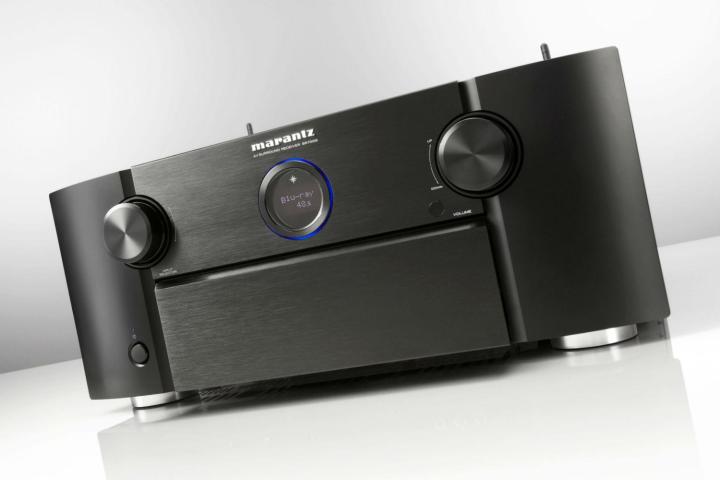
Related article: Everything you need to know about Dolby Atmos coming to home theater
SR6009 7.2 channel network receiver ($1,300)
Like a good rock show, we’ll begin with the warm-up act. While the SR6009 may not be Dolby Atmos ready, those looking for top-notch performance from a standard surround sound receiver will find it here. Cut from the same cloth as its predecessor, the SR6008, the latest version offers premium construction and that minimalist Marantz look thanks to its sleek aluminum trapdoor that hides the front panel controls and inputs.
Under its aluminum shield, the SR6009 boasts a bundle of premium components, including Marantz’s HDAM circuitry, designed to supplant standard integrated circuitry for reduced noise level and extremely accurate sound performance. The system puts out a claimed 110 watts of power per channel, and also offers some nice extras like Marantz’s latest ECO mode for reduced power consumption, and Audessey MultEQ XT for easy speaker calibration.
Hi-res files are the unit’s bread and butter, and it can stream a plethora of files wirelessly over a network at high resolution, including FLAC and ALAC at a max 192Hz/24bit, as well as DSD and AIFF files. The system also sports Airplay support, Internet radio, Spotify Connect, and Pandora, along with Bluetooth streaming from a mobile device. The receiver will, of course, also decode DTS-HD Master Audio, and Dolby TrueHD.
Inputs include 7 HDMI 2.0 ports at the back and 1 at the front, an iPhone-ready USB port, and a top-tier moving magnet (MM) phono input for vinyl record lovers. As expected, video processing is primed and ready for the next gen of 4K displays, as well, with the latest requirements for 60Hz 4K video passthrough.
SR7009 9.2 channel network receiver ($2,000)
With the SR7009, you get all the love from the understudy, and a little bit more. The focal point of the batch of extras is the Dolby Atmos. To incorporate the Atmos speakers, which fire either from the ceiling, or from the ground to reflect off of the ceiling, the system utilizes its 125 watts of 9 channel power in several configurations. Those including a 5.1 channel setup with 2 Atmos speakers (5.1.2), a 5.1 channel with four Atmos speakers (5.1.4), and a 7.1 channel setup with 2 Atmos speakers, (7.1.2). In addition, users can add a stereo amplifier to the system to expand to 7.1.4 and 9.1.2 configurations.
Other features added for the SR7009 include DSP for Audyssey DSX, or DTS Neo:X11.1 to decode up to 11.2 channel audio feeds, a 13.2 channel pre-amp output, advanced room correction mode software, and 3 HDMI outputs for a “2+1 zone” output, which we take to mean 2 fully functional HD video zones, and an extra audio zone to fill your house with entertainment.
We’ve included a breakdown of all of the featured specs for both receivers below.
SR6009 featured specs
- Wi-Fi and Bluetooth
- Current Feedback topology and new Marantz HDAM
- 7 channel discrete power amplifier, 110 watts/channel
- New small trapdoor design; aluminum front panel
- Dolby TrueHD and DTS HD Master Audio
- Audyssey MultEX XT room calibration
- Audyssey DSX, DTS-Neo:X (7.1 channel)
- HDMI 2.0 with 4K50/60Hz
- HDMI scaling 1080p, 4K 50/60Hz
- MP3, WAV, AAC, WMA AIFF
- HD Audio streaming: FLAC, ALAC (192/24), and DSD
- Gapless playback
- USB port
- vTuner Internet Radio, Spotify Connect, Pandora, Sirius XM
- Phono MM input
- Setup assistan and advanced GUI
- 7.2 ch pre-out, RS232
- 7.1 ch External Inputs
- Marantz Remote App for iOS and Android
- Eco mode
SR7009 additional specs
- Dolby Atmos
- 9 channel discrete power amplifier, 125 watts/channel
- Audyssey MultEX XT32, LFC
- Audyssey DSX; DTS Neo:X (11.1 channel)
- Audyssey Sub EQ HT
- 3 HDMI out (2+1 zone)
- 11.2 channel signal processing, 13.2 channel pre out (for two independent subwoofers)
If you’re looking for a serious home theater upgrade, both of Marantz’ new home theater toys are slated to arrive in stores this September.
Editors' Recommendations
- What is Dolby Atmos Music, and how can you listen to it at home and on the go?
- Pioneer’s latest budget-friendly Dolby Atmos AV receivers start at $379
- You Asked: VR home theater, universal remotes, and Dolby Atmos music
- TCL goes all-in on Dolby Atmos with its first 7.1.4-channel soundbar
- Samsung’s new Dolby Atmos wireless speaker doubles as a picture frame


